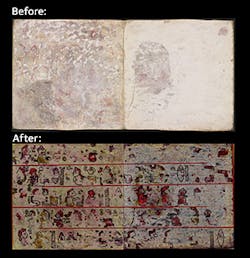Hyperspectral imaging sees through plaster-covered Mesoamerican codex
Researchers from the Bodleian Libraries at the University of Oxford (Oxford, England) and from universities in the Netherlands have used hyperspectral imaging to uncover the details of a rare Mexican codex dating from before the colonization of the Americas. The newly revealed codex, or book, has been hidden from view for almost 500 years, concealed beneath a layer of plaster and chalk on the back of a later manuscript known as the Codex Selden, which is housed at the Bodleian Libraries. Scientists have used hyperspectral imaging to reveal pictographic scenes from this remarkable document and have published their findings in the Journal of Archaeological Science: Reports.
RELATED ARTICLE: Sixth-century manuscript makeup decoded via spectroscopy
Ancient Mexican codices are some of the most important artefacts of early Mexican culture and they are particularly rare. Codex Selden, also known as Codex Añute, dates from around 1560 and is one of fewer than 20 known Mexican codices to have survived from pre-colonial and early colonial Mexico. Of those, it is one of only five surviving manuscripts from the Mixtec area, now the Oaxaca region of Mexico. These codices use a complex system of pictures, symbols and bright colors to narrate centuries of conquering dynasties and genealogies as well as wars and the history of ancient cities. In essence these codices provide the best insight into the history and culture of early Mexico.
Since the 1950s, scholars have suspected that Codex Selden is a palimpsest: an older document that has been covered up and reused to make the manuscript that is currently visible. Codex Selden consists of a five-meter-long strip composed of deer hide that has been covered with gesso, a white plaster made from gypsum and chalk, and folded in a concertina format into a 20-page document. The manuscript underwent a series of invasive tests in the 1950s when one page on the back was scraped, uncovering a vague image that hinted at the possibility that an earlier Mexican codex lay hidden beneath.
Until now, no other technique has been able to unveil the concealed narrative in a non-invasive way. The organic paints that were partly used to create the vibrant images on early Mexican codices do not absorb x-rays, which rules out x-ray analysis that is commonly used to study later works of art.
Some pages feature more than 20 characters sitting or standing in the same direction. Similar scenes have been found on other Mixtec manuscripts, representing a King and his council. But the analysis of this particular text shows that the characters are both male and female, raising interesting questions about what the scene represents.
The imaging has also revealed a prominent individual who appears repeatedly on the document and is represented by a large glyph consisting of a twisted cord and a flint knife. The name seems to resemble a character found in other Mexican codices: the Codex Bodley (in the Bodleian's collection) and Codex Zouche-Nuttall (in the British Museum).That character is an important ancestor of two lineages connected to the important archaeological sites of Zaachila and Teozacualco in Mexico. However, further analysis is needed to confirm that it is the same individual.
The researchers analyzed seven pages of the codex for this study and revealed other images including people walking with sticks and spears, women with red hair or headdresses and place signs containing the glyphs for rivers. They are continuing to analyze the remainder of the document with the aim of reconstructing the entire hidden imagery, allowing the text to be interpreted more fully.
"Hyperspectral imaging has shown great promise in helping us to begin to reconstruct the story of the hidden codex and ultimately to recover new information about Mixtec history and archaeology," said David Howell, head of Heritage Science at the Bodleian Libraries. "This is very much a new technique, and we've learned valuable lessons about how to use hyperspectral imaging in the future both for this very fragile manuscript and for countless others like it."
Working with the Humanities Division in the University of Oxford, the Libraries acquired the hyperspectral scanner in 2014 with the support of the University’s Fell Fund. Once a technique used by astrophysicists to study the color of stars, hyperspectral imaging is now used by Bodleian researchers to reveal hidden text and images and identify unknown substances and pigments with a high degree of accuracy. Researchers have recently used the scanner to clarify the text of the famous Bakhshali manuscript from India, which includes the first use of zero, to analyse the medieval Gough Map, the earliest road map of Great Britain and to reveal a hidden devil in a centuries-old Armenian gospel-book.
SOURCE: University of Oxford; http://www.bodleian.ox.ac.uk/bodley/news/2016/aug-16
About the Author

Gail Overton
Senior Editor (2004-2020)
Gail has more than 30 years of engineering, marketing, product management, and editorial experience in the photonics and optical communications industry. Before joining the staff at Laser Focus World in 2004, she held many product management and product marketing roles in the fiber-optics industry, most notably at Hughes (El Segundo, CA), GTE Labs (Waltham, MA), Corning (Corning, NY), Photon Kinetics (Beaverton, OR), and Newport Corporation (Irvine, CA). During her marketing career, Gail published articles in WDM Solutions and Sensors magazine and traveled internationally to conduct product and sales training. Gail received her BS degree in physics, with an emphasis in optics, from San Diego State University in San Diego, CA in May 1986.
